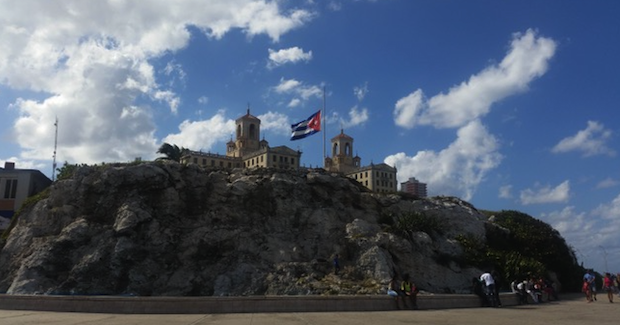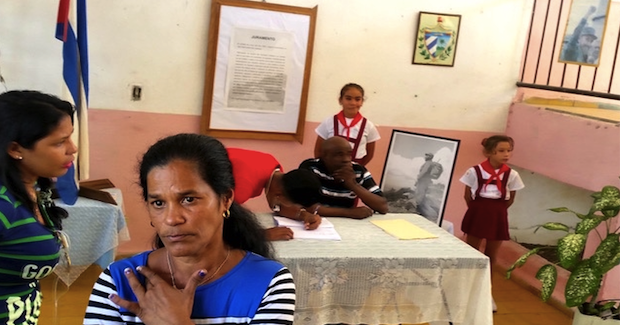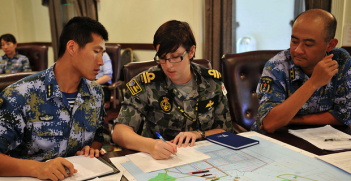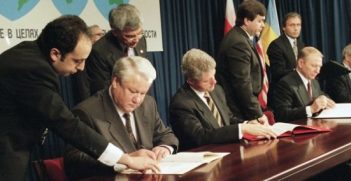Half-Mast in Havana

The death of Fidel Castro on the weekend has brought a sombre mood to Havana as Cubans there and around the country reflect on the life and impact of El Comandante. But the Cuba envisaged by Castro is already disappearing due to the economic and political reforms of his younger brother, Raúl.
Weekends in Havana are usually festive. Families bustle through the crowded street markets to the backdrop of animated negotiations and the latest salsa tracks. But this weekend, the streets were calm and downcast. Television and radio stations were maintaining a sombre stream of news about the life and times of El Comandante. Even the tourist restaurants stopped serving alcohol and sent their bands home.
I heard the news of Fidel’s passing at 8:30am on Saturday from my neighbour as we passed on the staircase of the five-storey building where I stay. The 35-year-old manicurist is usually ready to joke about the trials of daily life despite being unable to find stable employment for the 15 years I’ve known her. When I asked how she felt, she forced a few words through strained lips: “Sad…We all knew he was sick, but…”. She had to stop to fight back tears.
Some of my friends are affected in less emotional but more practical ways. They make their living from music and ritual drumming for the Afro-Cuban religion Santería. To their dismay, the Council of State decreed that, “all public activities and performances will be suspended for nine days of national mourning.” Miki, the owner of the sacred batá drums, had to cancel his rumba show, and his religious ceremonies are all suspended because they involve drumming. He has taken the initiative: “I’ve sent Jorge to the police station to ask for a permit because for us this is the only way to make a living.” At the lower end of the socioeconomic spectrum, Miki and his community are not afraid to complain: “The cartoons have all been cancelled to show this political stuff …What’s my daughter supposed to watch?”
Today marks four days since Fidel’s passing, and it is safe to say that feelings are mixed. At 9am 21 cannon shots boomed across the city, cutting through the Monday morning traffic as a reminder that life has not returned to normal. Many have been given the day off work to venerate Fidel’s ashes in Revolution Plaza. And at more than a thousand schools and clinics across Havana citizens have been urged to sign a “book of condolences”.
At one of these locations, a primary school in the lower-class neighbourhood of Arroyo Naranjo, I asked an elderly Afro-Cuban woman what the book of condolences meant to her. “I always tell people that I am not Communist,” she asserted with a raised finder, “but that I am Fidel-ist. Before the Revolution I worked for a wealthy white family, who made me carry buckets of water from 7am to 7pm and scrub their bathrooms nonstop. I wasn’t allowed to go to the beach with them because of my skin. It’s indisputable that Fidel put an end to that!” A young man joined the conversation with a quiet but intense tone: “I was born in the 1980s but my father told me how things were, and I’ll always defend Fidel for raising up people of colour.”
After the nationalisation of foreign businesses in the 1960s and mass mobilisations to educate the population, Fidel did not drive major changes in Cuban politics. But since his brother Raúl took over as president in 2008, the island has implemented a range of reforms that even the conservative US think tank Freedom House admits are “driving genuine change”. Consequently, more than 450,000 Cubans are now self-employed (up from 150,000 in 2010), and chic privately operated cafés and restaurants are popping up around the city. The growth of tourism to 3.5 million visitors in 2015, from just 300,000 in 1990, has brought new opportunities for many of Cuba’s 11 million citizens.
Change is also underway in the political system. At the last Communist Party Congress in mid-2016, rules were implemented to bring new blood into the elite Central Committee. Previously staffed by Fidel’s ageing comrades, the committee will henceforth only accept new members who are younger than 60, and will force those older than 70 to retire. Furthermore, three of the 2016 intakes come from scientific and industrial backgrounds instead of more traditional political careers.
Cuba’s international profile is evolving too. In 2015, the United States and Cuba reinstated diplomatic ties after 54 years of estrangement, and in March 2016 Barack Obama became the first sitting US president to visit the island in 88 years. European and Asian delegations are now a common sight in Havana, and this year former Australian Trade Minister Andrew Robb led the first Australian trade mission to Cuba. As part of his delegation I was struck by the enthusiasm of Cuban officials—absent during Fidel’s reign—to develop commercial ties in everything from renewable energy to food security.
Watching these changes from Canberra, the Department of Foreign Affairs and Trade is now funding Cuban engagement projects in areas as diverse as street art, restoration of historical archives, and organic food production. These initiatives show that Cuba’s priorities are changing: from tireless advocacy of social justice under Fidel to internationally engaged economic pragmatism under Raúl.
The music will inevitably return to Havana, but life after Fidel may usher in a period of emotional ambivalence. The nine-day mourning period is exposing deeply contrasting feelings about the balance of political allegiance with daily economic survival. And yet, for now at least, my neighbour will go back to her precarious job with a smile.
Adrian H. Hearn is associate professor of Spanish and Latin American studies at the University of Melbourne. He is the author of “Cuba: Religion, Social Capital, and Development” and “Diaspora and Trust: Cuba, Mexico, and the Rise of China”.
This article is published under a Creative Commons Licence and may be republished with attribution.





